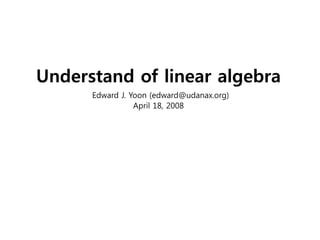
Understand Of Linear Algebra
- 1. Understand of linear algebra Edward J. Yoon (edward@udanax.org) April 18, 2008
- 2. What is the Matrix? • A matrix is a set of elements, organized into rows and columns rows a b c d columns
- 3. Matrix Operations f a e b f a b e c d g c g d h Just add elements h f a e b f a b e c d g c g d h Just subtract elements h f ae bg af bh a b e Multiply each row ce dg c d g cf dh by each column h
- 4. Vector Operations • Vector: 1 x N matrix a • Interpretation: a line in N dimensional v b space • Dot Product, Cross c Product, and Magnitude defined y on vectors only v x
- 5. Vector Interpretation • Think of a vector as a line in 2D or 3D • Think of a matrix as a transformation on a line or set of lines x a b x' y c d y '
- 6. Dot Product • Interpretation: the dot product measures to what degree two vectors are aligned A A+B = C (use the head-to-tail B method to combine vectors) C B A
- 7. Dot Product d a b abT a b c e ad be cf Think of the dot product as a matrix multiplication f The magnitude is the dot a aaT aa bb cc 2 product of a vector with itself The dot product is also related to a b a b cos( ) the angle between the two vectors – but it doesn’t tell us the angle
- 8. Cross Product • The cross product of vectors A and B is a vector C which is perpendicular to A and B • The magnitude of C is proportional to the cosine of the angle between A and B • The direction of C follows the right hand rule – this why we call it a “right-handed coordinate system” a b a b sin( )
- 9. Inverse of a Matrix • Identity matrix: AI = A • Some matrices have 1 0 0 an inverse, such that: 0 1 0 AA-1 = I I • Inversion is tricky: (ABC)-1 = C-1B-1A-1 0 0 1 Derived from non- commutativity property
- 10. Inverse of a Matrix 1. Append the identity matrix to A 2. Subtract multiples of the a b c 1 0 0 other rows from the first d e f 0 1 0 row to reduce the diagonal element to 1 g h i 0 0 1 3. Transform the identity matrix as you go 4. When the original matrix is the identity, the identity has become the inverse!
- 11. Determinant of a Matrix • Used for inversion a b A • If det(A) = 0, then A c d has no inverse • Can be found using det( A) ad bc factorials, pivots, and cofactors! 1 d b 1 A • Lots of ad bc c a interpretations – for more info, take 18.06
- 12. Determinant of a Matrix ab c f aei bfg cdh afh bdi ceg de gh i ab ca b ca b c Sum from left to right de fd e fd e f Subtract from right to left Note: N! terms gh ig h ig h i
- 13. Homogeneous Matrices • Problem: how to include translations in transformations (and do perspective transforms) • Solution: add an extra dimension 1 x 1 y x z 1 y 1 z 1 1
- 14. Ortho-normal Basis • Basis: a space is totally defined by a set of vectors – any point is a linear combination of the basis • Ortho-Normal: orthogonal + normal • Orthogonal: dot product is zero • Normal: magnitude is one • Example: X, Y, Z (but don’t have to be!)
- 15. Ortho-normal Basis x 1 0 0 x y 0 T y 0 1 0 xz 0 T z 0 0 1 yz 0 T X, Y, Z is an orthonormal basis. We can describe any 3D point as a linear combination of these vectors. How do we express any point as a combination of a new basis U, V, N, given X, Y, Z?
- 16. Ortho-normal Basis n1 a u b u c u a 0 0 u1 v1 0 b 0 u n2 a v b v c v v2 2 0 0 c u3 n3 a n b n c n v3 (not an actual formula – just a way of thinking about it) To change a point from one coordinate system to another, compute the dot product of each coordinate row with each of the basis vectors.
